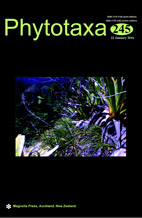Abstract
Holocene shallow-water carbonate and mixed siliciclastic-carbonate deposits from the Arraial do Cabo Bay, Brazil, southwestern Atlantic, contain well-preserved coralline red algae. These comprise four species of three genera representing the subfamilies Lithophylloideae, Mastophoroideae and Melobesioideae: Lithophyllum pustulatum, Spongites fruticulosus, Spongites yendoi, Mesophyllum engelharti. Geniculate corallines are present as algal debris. This study represents the first fossil record of these species in southwestern Atlantic Ocean. They inhabited the studied area since at least 13.000 years and are still thriving in the present-day assemblages. Only L. pustulatum and S. fruticulosus have old fossil records traced back into the Oligocene from the Mediterranean region.
From ca. 3.000 years ago these species thrive in intertidal settings along the southwestern Atlantic Ocean coasts, which have been characterized by a regressive sea-level trend.

